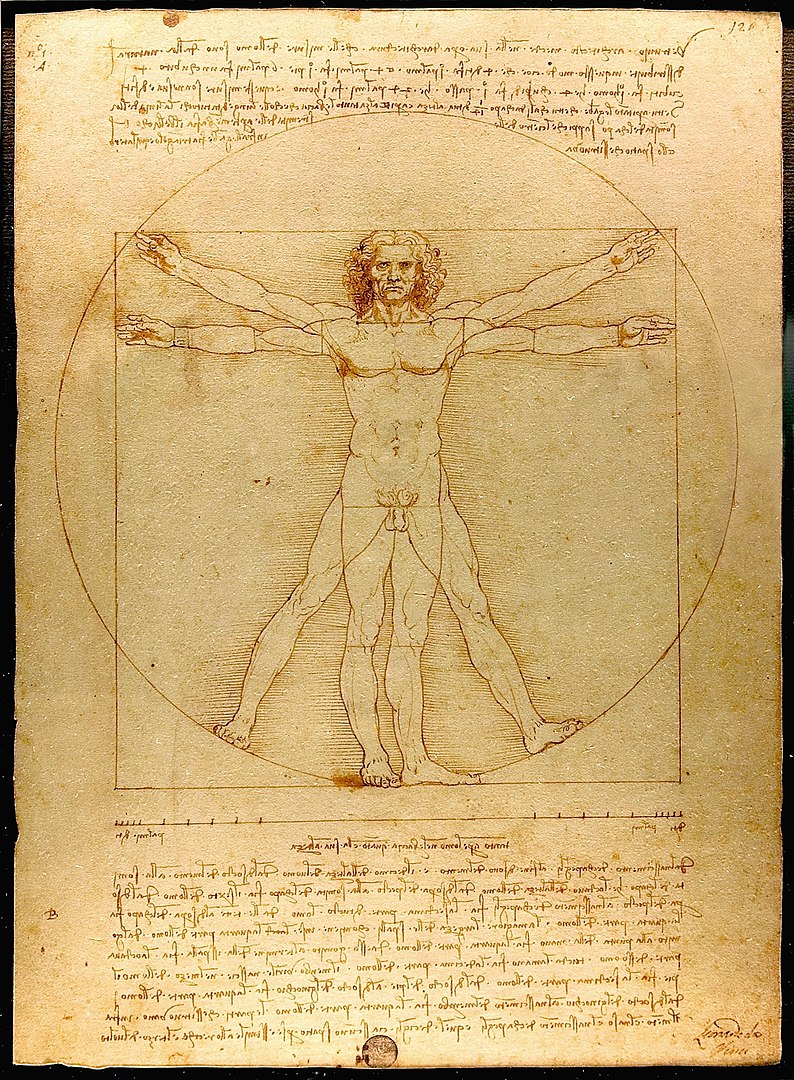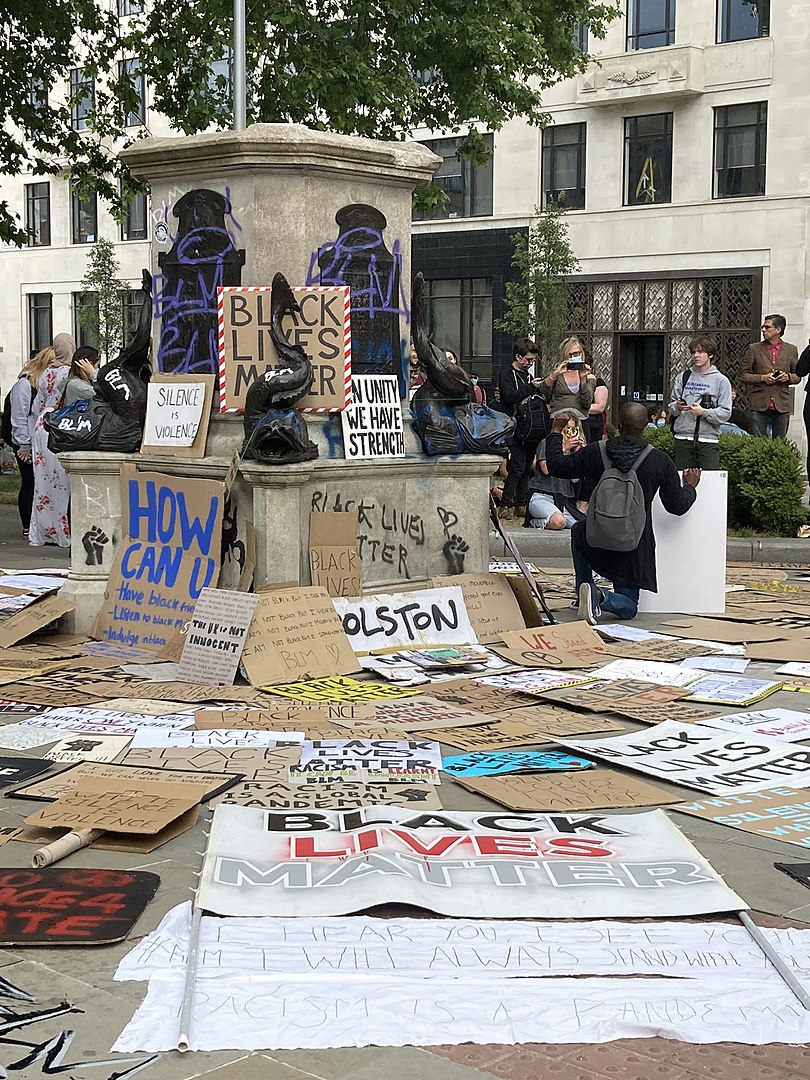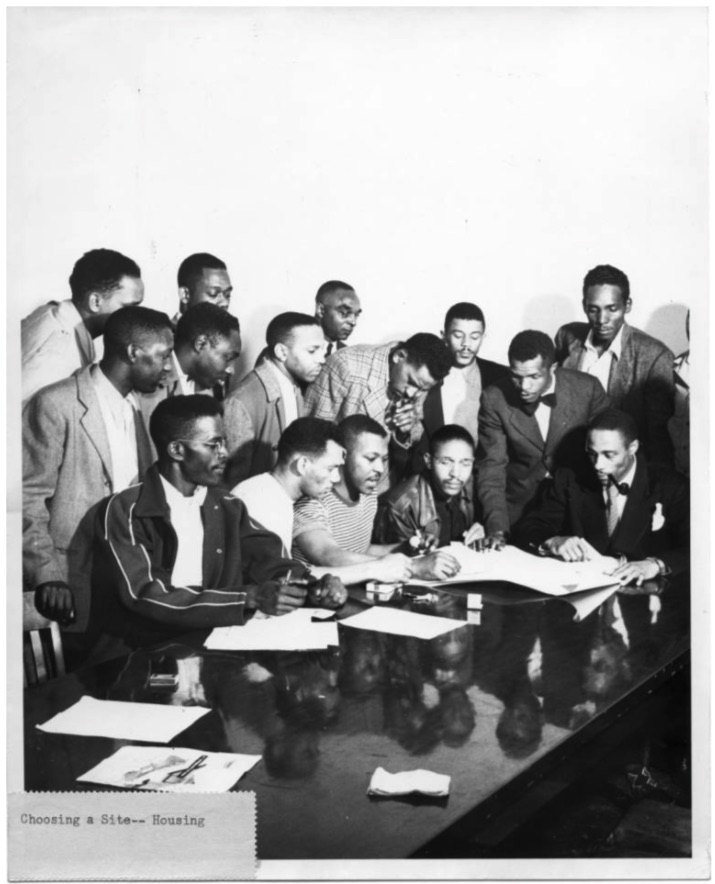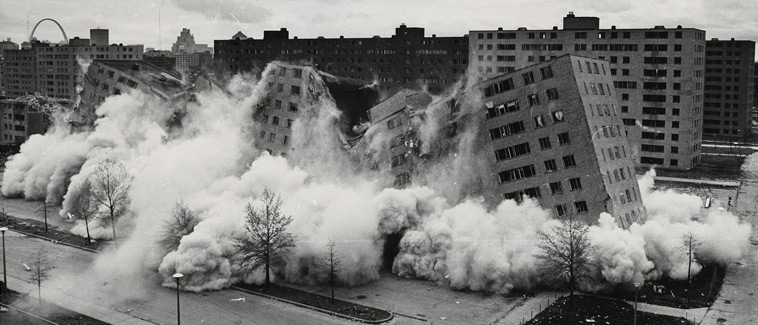Last month, in response to public demonstrations and support for the Black Lives Matter movement, Architectural Record began reaching out to architects and designers to explore racism in the profession and the built environment. As part of that ongoing conversation, RECORD convened a panel of three professionals in practice and education: Mabel O. Wilson, Mario Gooden, and Justin Garrett Moore.
Wilson is a Professor at the Columbia University Graduate School of Architecture, Planning and Preservation (GSAPP), whose field of scholarship is architecture and race. She also has a design practice, Studio &, and is part of the team that designed the just-completed Memorial to Enslaved Laborers at the University of Virginia. At Columbia, she co-directs the Global Africa Lab with Mario Gooden, who is a professor of practice at the GSAPP and founding principal of the firm Huff + Gooden. His work engages the cultural landscape and the intersectionality of architecture, race, gender, sexuality, and technology, and bridges architectural design and writing, research and performance. Moore, the executive director of the New York City Public Design Commission, has extensive experience in urban design and planning, focusing on excellence in the public realm and fostering accessibility, diversity and inclusion. An adjunct faculty member at Columbia, he is co-founder of Urban Patch, which supports the equitable revitalization of communities.
Wilson, Gooden and Moore spoke together with RECORD Editor-in-chief Cathleen McGuigan.
Cathleen McGuigan: I want to begin by asking how racism has shaped and operated in architecture, both as a practice, and in the environment that architecture has built.
Mabel O. Wilson: The idea is, typically, to be inclusive and to bring people into educational institutions and disciplines, but the challenge is that those spaces, those structures, are already racialized. And to understand that, and start to talk about whiteness and white supremacy—whether the oppressor is a human or a system—is really vital for change. As people of color, we can’t just continually describe what we're experiencing without everyone understanding the origins.
Justin Garrett Moore: The predominantly white, male profession needs to focus on this. What happens typically is, “Okay, we need to hear from people of color, we need to learn and we need to listen,” and it becomes like a hamster wheel. Black people are tired of having that conversation over and over again—but I think this pivot that Mabel has introduced is having the conversation about whiteness. It’s so important—it really needs to be the arrow to the heart at this critical time.
Mario Gooden: Yes, the issues need to be unpacked from the other side. Perhaps it can be uncomfortable for those in the profession to put the mirror on themselves. We as Black architects understand those systems. But it's time for you, the profession, to really come to terms with it and own it—and then let's figure out how to dismantle it.
Mabel, the subject of whiteness in the built environment is a big part of your research and scholarship. Can you start to enlighten us?
In my 30 years as an academic, and also having worked in practice, I have come to really understand how much whiteness permeates what we do, from how we are educated in architecture and, really, what architecture is.
–Mabel O. Wilson
Mabel O. Wilson: How does racism operate—and not just anti-Black racism, but also whiteness and white supremacy? Fundamentally, it is the power relations that the concept of race enables, in a range of practices and disciplinary frames. In my 30 years as an academic, and also having worked in practice, I have come to really understand how much whiteness permeates what we do, from how we are educated in architecture and, really, what architecture is. I see architecture as the European art of building that Leon Battista Alberti described—a European way of understanding building.
Filippo Brunelleschi, you know, designed his famous dome not long before Christopher Columbus sailed, right? So at a moment of colonial encounter, and the rise of Renaissance humanism, comes this sense of the European understanding himself in relationships to others. So race has to be conceptualized. It is not natural, but a construct. Yet is has real implications in terms of how architecture is created within those relationships of the nation state, and the bodies of knowledge of philosophy, technology, racial science—and they all have their own impacts on the discipline of architecture and on the discipline of architectural history.
In the West, the concept of the past is riddled with racial assumptions about who was civilized, who was progressive and modern, and who was primitive—who was ahistorical and left behind.
And when we have to read Adolf Loos on ornament and crime in school, it is a racial narrative of white European cultural superiority, of what it means to be civilized and modern, but it's rarely taught that way at all. It's taught about a polemic to remove ornament and advance beyond folk culture, so that it's about “progress.” Thus, it's important to recognize how deeply race is embedded in the discipline, and also in civil society—all the things that shape us as beings, our ontology and epistemology in the ways we know the world.

Mario Gooden: Whiteness is at the heart of architecture as a discipline. People tend to think of white supremacy as being about people in white hoods. But white supremacy is a hierarchical system of patterns and practices that continuously privileges the white subject and consistently disadvantages the Black body and people of color. This really goes back to the foundation of architectural theory rooted in Vitruvius’s ideal man—a white male European subject—that is formulated and inscribed in architecture in Vitruvius’s Ten Books on Architecture. So the discipline of architecture as a system of orders and rules that we follow is all predicated upon that ideal subject.
And then when we come to modernism, which assumes what I call the myth of the universal subject, we are still dealing with white male European subjectivity. This stems from Georg Wilhelm Friedrich Hegel, who wrote in his Philosophy of History that the Negro lacks subjectivity, consciousness, and had nothing to provide to civilization. Hence from the Enlightenment to today, European epistemology is based upon this white subject that we continue to perpetuate in architecture schools. Even for schools that claim the mantle of experimentation, the conditions of white supremacy continue within the confines of the discipline. And discipline means to follow a set of rules, a set of orders, or else you are subjected to retribution, punishment, or the assessment that your work doesn’t belong.
So other bodies are excluded—Black bodies, Brown bodies, people of color—if they aren't following those orders, and that they are somehow in need of bringing back into the discipline. We've heard a lot in the last 10 to 15 years about the re-disciplining of architecture and that architecture should not be engaged in cultural critique or critical theory. Those voices made the claim that architecture needed to be brought back from its margins. This was and is really a kind of conservative backlash and desire for reinstating the privileged white male point of view—away from, for example, discussions from the late 1970s through the ‘90s of architecture and gender; architecture and sexuality; and architecture and race.
Mabel O. Wilson: Can I just add what I always describe as the boys jumped into cyberspace? With people adopting the computer and paperless architecture in the 90s—and the guys with their algorithms. In a way, with the adaptation of parametrics and fabrication, there was a recuperation of masculinity. And that jump flattened any understanding of what became known as identity politics—race, feminism, and sexuality—in architecture.
Mabel and Mario, please talk about the Global Africa Lab that you co-direct at the Columbia University GSAPP, where you break with the European-centric model that has ruled architecture.
Mario Gooden: When we started Global Africa Lab about seven years ago, it was really looking at the world in terms of architecture and urbanism through the lens of what had been excluded from architecture—and that is the African subject or the Negro subject that Hegel had excluded.
The majority of the world exists in the Global South. Architecture and building had been going on there for centuries before Europe. So the question is, what can we learn from those places that have not been brought into the discourse of architecture?
–Mario Gooden
The lab is not just about the African continent, it's about the diaspora. Our work has been on the continent, yes, but it's also been in Detroit, in other places in the States, and in South America, and in Europe. To be clear, the majority of the world exists in the Global South. Architecture and building had been going on there for centuries before Europe. So the question is, what can we learn from those places that have not been brought into the discourse of architecture?
Mabel O. Wilson: And while those places in the diaspora weren't brought into the discourse of architecture, they were still necessary for architecture’s imagination. Africa is central to the creation of whiteness and the concept of Europe through constant scientific, cultural, and historical comparison with those colonized in Asia, Africa, and the New World. There was even the incorporation and desire for African motifs in modernism—masks and textiles—whose legacy has been studied more thoroughly in art history, for example. Part of what Global Africa Lab is trying examine is to show that modernity is not possible without the African continent. African people, resources, land, and culture are how the modern is imagined and how the project of the transatlantic slave trade literally builds the wealth of capitalism as racial capitalism.

As we've seen with the recent toppling of the monument of the slave trader Edward Colston in Bristol, England, you cannot have an industrial revolution in England without the mills receiving cotton from India and Jamaica. The Lab is trying to foreground that history, but also emphasize contemporary global linkages by looking at what is happening in the urban spaces of Rio de Janeiro; Detroit; Dakar, Senegal; and Cape Town.
Justin, you work extensively in urban design and planning—can you talk about how our cities have come to be so imbued with racism?
Justin Garrett Moore: The conversation about white supremacy and racism is important, but we equally need to put the focus on the racist—not only the “ism” or the system. One of the ways that architecture and the built environment work is by distancing and “othering.” We talk all the time about the policies—whether it's redlining or urban renewal, or the disciplines being regulated—that then become abstract systems of racism. But we don't spend enough time talking about the racist white people that built those systems. It’s still acceptable for individuals to not take responsibility for that. So, was Robert Moses a complicated figure? Was Thomas Jefferson a complicated figure? That conversation is not had enough.
There is a gap between being racist and racism existing. Very often we see people operating in ways that are racist but they would never self-identify to say, “I'm being racist.” They'll say that “racism is the system that I'm operating within. That's not me, that's not my action.” That kind of reflection doesn't happen.
That’s why we see difference and racism persist in systems and structures like policing. And when we discuss urbanism, we see the same things, but scaled up and exaggerated, into operations that radically are transforming and shaping space. We get the collective, environmental version of “othering.” The white suburb versus the inner city, all of these dynamics are just so ingrained and embedded. And through language, through practice, through culture, all of that racism is acceptable—regardless of the very tangible, real, visible, negative impacts. What is it about white people or people who are in power or have agency that allows that?
To shape space or to control capital or to create conditions—what we're doing as designers constantly is manipulating how space and people operate. That's our job. And architecture is very smart about new ways to exploit and categorize people.
–Justin Garrett Moore
To shape space or to control capital or to create conditions—what we're doing as designers constantly is manipulating how space and people operate. That's our job. And architecture is very smart about new ways to exploit and categorize people.
Mabel, beyond what we have already discussed, what specifically have been your own encounters with racism in architecture?
Mabel O. Wilson: As my initial introduction into architectural education, I never saw myself reflected. How many times have each of us been the first Black person hired in the office? Once I was the second person, and that was huge. And when I decided I wanted to do a Ph.D., the logical place would have been architectural history. But lo and behold, I didn't get into the two architectural history programs I applied to—but I did get into an American studies program. About a year later, I got a call from the dean of one of those institutions with a big fat apology saying, “Oh, I'm sorry, we should have probably let you into our Ph.D. program.” Apparently, I was just a very controversial applicant, and I guess some of the older faculty just didn't feel comfortable with me and what I wanted to work on, which was race and architecture. That was not relevant to the field 35 years ago.
Justin Garrett Moore: For me, the most violent or vile example is erasure. Think of “blight” elimination or urban renewal. There's a pipeline problem, yes—not enough Black kids have exposure to architecture and enter the field. That is true. But once you are in this field, the understanding of your culture, your kind of knowledge, your value is just completely erased. It puts one in this very difficult space, emotionally and mentally, where it's very challenging to find power, a base and a platform for your work, because over generations, if not centuries, there has been this complete destruction of everything that is connected to you.
I have many, many different versions of erasure, but I just want to talk through a couple of them to understand how wide-scale and systemic it is.

In Indianapolis, where I grew up, there's this really incredible, wonderful project called Fall Creek Homes, done by an organization called Flanner House. In the ‘30s and ‘40s, they did a lot of social service work in the Black community. Different supporting organizations, such as the Quakers, developed an incredible community redevelopment plan that included parks and flood mitigation design for the neighborhood. And it included self-help housing construction, with Black leadership and Black architects—Hilyard Robinson was the architect—and with a complete conception, generated by how these Black people in this community chose to make urban space. It’s a great story. I did seven years of education in architecture and design at presumably elite schools. And I learned a lot about what white men think about cities, and what white men think about Black people in cities, and what white men did to Black people in cities, and what Black people couldn't do in cities. And every time as a student, I would kind of challenge and push my knowledge of Fall Creek, I would get, “Oh, that's interesting, but let’s talk about this instead.” That literally happened to me over and over again in my career. But this was my history—I found out later in life that my grandfather was one of the people who did that work—and yet it was absent, erased. I get in trouble for saying this, but the Black people that we learned about were typically sort of contorted into being European, or modernist, or being near-white, frankly. Their work was considered valuable.
A second form of erasure is when you're in offices, you are constantly erased. Because of all the dynamics and systems at play, very often Black people are in some form of disadvantage. It’s just hard because you're doing your work, and you're bringing your value and knowledge, but it's not seen as valuable. It may not be reflecting things that the dominant culture cares about and can relate to. What you're presenting is simply not right—it happens in school, it happens when you go into an office.
And another version is in university admissions. Architecture schools are continually building a community for who gets to participate in design. I was doing admissions and we got applications from all over the world, a lot of students from Asia, some from Europe and Latin America. And I was lamenting to the others on the committee, “Wow, I really wish we had more Black students and students from Africa.” And someone commented, “Well, there are over a billion people in China and they really need to have the best education and access to this kind of knowledge.” So I challenged that—there are over a billion Black and African-descent people in the world.
That level of just pure dismissal of Black people and African people we know is pervasive. The schools say they are global—but it is acceptable to be global and international and diverse to the exclusion of Black people explicitly, and people of African descent explicitly. It’s just fine!
To be Black and in architecture, you cannot be mediocre: to be visible, you have to be excellent. And you have to be excellent at every second of every moment of the day... Yet, sometimes, even with excellence, you can still be invisible.
–Mario Gooden
Mario Gooden: This also operates in very subtle ways. To be Black and in architecture, you cannot be mediocre: to be visible, you have to be excellent. And you have to be excellent at every second of every moment of the day. This is a very subtle but heavy burden that we, and our Black students, are carrying every day. When I grew up, this is one of the first things my mother taught me. I know Justin's parents probably told him the same, as Mabel’s did as well, that you have to be twice as good. Yet, sometimes, even with excellence, you can still be invisible.
Justin Garrett Moore: A lot of people will talk about Black people having what W.E.B. Du Bois called the veil or double consciousness, and having to live in two worlds. It’s challenging and, sometimes, demoralizing.
How can the profession—within both practice and education—work toward an anti-racist position? What has to happen?
Mabel O. Wilson: When Obama became president, we as a nation claimed that we were post-racial, but we clearly are not. And that's a very difficult thing to comprehend, because if race structures the world for everyone and not just for Black people, the trick that racism does is that it makes itself transparent—especially to those who can claim “the wages of whiteness,” David Roediger’s term for white privilege—and cannot perceive how race operates, or that they are racialized, too.
And people don't like to bring up race because it makes them uncomfortable, and you quite frankly don't like or want to shame people. But we all have to be accountable, so when someone is erased, someone else has done the erasure. How then should someone be accountable for those actions and the institutional frameworks that allow those actions to occur, to be validated?
I've heard people say, “Why should I be accountable for the sins of my father? Slavery, Jim Crow is in the past.” But I would say that if you're white, you benefit from that history. You have opportunities, advantages and wealth. And even if you’re poor and white, according to statistics you will still possess more wealth than most Black people. This historical difference in wealth is what allows white Americans to live well, and then pass that wealth on to the next generation. And at the other end of those benefits and privileges, we find historical legacy of deprivation and struggle, when you don’t have those opportunities and will not inherit wealth because of slavery and Jim Crow segregation. We have to look at who benefits and who struggles.
We need a holistic accounting of the impact of race in the U.S. I think there are ways to be critically distanced in order to begin to understand and articulate that legacy, but as Black people, we can’t be the only ones to do that work. It has to be done by those who benefit from whiteness. That is the work that has yet to be done.
The profession is in crisis, and perhaps it has been for a very long time. It’s in crisis not only because it has been complicit with the systems that we've been talking about, but also because it's given away its agency.
–Mario Gooden
Mario Gooden: The profession is in crisis, and perhaps it has been for a very long time. It’s in crisis not only because it has been complicit with the systems that we've been talking about, but also because it's given away its agency, in terms of how the city gets formed. Just take New York City, for example, in which the architects have ceded their influence to the developers of Hudson Yards, or to the super-rich commoditization of architecture along Billionaires Row on 57th Street.
The other truth is that it's very difficult to enter the profession unless you come from money. But because of structural racism and white supremacy, Blacks did not have the ability to acquire wealth through home ownership, for example, because of red-lining. Therefore, there was very little to pass from one generation to the next and the wealth disparities between Blacks and whites are enormous. Unless you're white and you have a lot of money, it's very difficult to enter the profession.
Hence, how do you support other modes of practice and recognize those as being just as important to the built environment? Practitioners may not be working for developers, but they are working in, let's say, cultural practice, trying to formulate different ways of questioning the discipline and making buildings in the public realm. Furthermore, professional organizations have to question themselves, and by that I mean the AIA, for example, really needs to question what it is that it’s supporting and what it is that it’s propping up.
Justin Garrett Moore: I would echo that practice has been so outmoded that it's no longer well-structured or equipped to serve people and the environment. It's very good at serving wealth and capital, but it's not so good at serving people and places. It is an everyday, common, and accepted practice that you could be paid well, with a lot of public money, to have white people in a room making decisions about what happens to Black people. I think that is unethical and the discipline has to revise, review, evaluate all of its codes of ethics and how it operates to enforce those unethical practices in the built environment, especially as they connect to people, our society and the work that needs to be done.
Mabel O. Wilson: Fundamentally, you have to look at how architecture in the West has always been allied with power and wealth, whether it's the monarchy, the state or private capital, and the church. As architects, how we work is speculative. We're always thinking about the future, which is why architecture allied easily with modernity’s concept of progress. Through our drawings we project the future, and that space of projection allows us to imagine that what we're doing is always morally good and will make the world better. But if that was the case, then how do you explain “poor doors”—separate entrances for affordable housing units in high rise development buildings in New York City? Or a past failure like Pruitt-Igoe housing in St. Louis? Buildings are erected but there is no social investment, no financial resources for maintenance. You end up with constant structural neglect and wholesale degradation of Black life in America.

Justin Garrett Moore: And the architecture profession still elevates these figures who did all these things as the most important people that every architect has to learn about and refer to. It’s crazy. What Mabel said was something I want to put a pin on, which was talking about care. We don't concern ourselves enough with care—or maintaining things or having a different orientation about what needs design and thought and creativity. And that radically needs to change.
Mario Gooden: We as a profession now also have to recognize the full humanity of who we're designing for—and within the schools and within the profession, we can't proclaim to be champions of the environment, designing for sustainability or for climate change, and not understand the relationships between race and climate change.
How do we get young people of color more interested in the profession so that people who are designing our world reflect our diverse society?.
Justin Garrett Moore: I have a positive story about how I got into architecture. I went to a probably 95 percent Black high school in Indianapolis. At the time, the school was getting a new gymnasium, and the MWBE contractor, Jimmy Beard, said to the architects on the project, “In order for me to work on this, you're going to hire students from this school to work in your office.” So as a 15-year-old Black kid, and as Ferguson-like protests against police violence flared in my neighborhood, I started working 40 hours a week as a summer intern for Jim Schellinger at CSO Architects in Indianapolis..
Providing opportunities for young people does not cost a lot; just a little money and making some time to care. This is something that a good number of the firms that read your magazine can do tomorrow.
–Justin Garrett Moore
I think they paid me something like $8 an hour—probably twice the minimum wage at the time. And it was great to have that early exposure, to see what people do, and to make some money. I got behind the curtain of the Wizard of Oz and saw that what these people were doing was not magic or completely exceptional. I saw and understood that I could do it, too. Providing opportunities for young people does not cost a lot; just a little money and making some time to care. This is something that a good number of the firms that read your magazine can do tomorrow
Mabel O. Wilson: But in practice, and in academic institutions, the conversation around whiteness has never happened. And until that does, real change can't be instituted, because you can't understand how race operates to produce inequalities. You're just trying to place the Band-Aid on something that's a far deeper social wound and problem.
Justin Garrett Moore: The final thing I would say circles back to the question of personal responsibility: that people need to do more than only say “What can I do,” or join a group, or go to a meeting or march. It needs to expand to the personal reflection, conversation, and evaluation that people need to engage around the issues of whiteness and anti-Black racism, and to really try to challenge themselves and each other. It’s uncomfortable, and it's going to take time, energy, and resources. This work shouldn't only be happening with allies, or only happening with Black and Brown people. It needs to happen at a much broader scale and with more people being willing to do the work.





Post a comment to this article
Report Abusive Comment